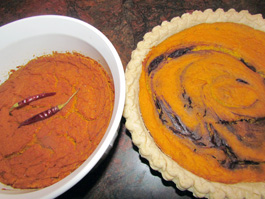home | north bay bohemian index | sonoma, napa, marin county restaurants | preview

PUDDING VS. PIE: For those horrified of cutting butter into flour, the crust-free route is always an option.
Squash Squad
It may seem crazy, but now's the time to delight in the simple pleasure of pumpkin pudding
By Ari LeVaux
Pumpkin pie is misunderstood in many ways. To name a few: it doesn't need to be sweet, it isn't only for the holidays, and, as far as I'm concerned, it doesn't even have to exist.
As much as I love pumpkin pie, I've been making pumpkin pudding more often, especially now, after the holidays and at the end of squash season, when pragmatic shopping can provide good deals. I say this carefully, knowing full well that in some circles an argument against pie is an argument against America. But there's no denying pumpkin pudding makes more sense, much of the time.
The difference between pie and pudding is crust, the very presence of which changes its contents from pudding to pie filling. If you can make a good crust, good for you; I hope somebody notices. But in my experience, crust is more liability than asset. The greatest crust won't rescue a bad pie, but a failed crust can embarrass an otherwise respectable one.
On more than one occasion, the thankless and messy task of crust making has dissuaded me from making pie altogether. If I attempt to make a crust, it means flour and dough are going to coat the kitchen. And the pie will probably break apart as I try to serve it, which is less impressive than just serving pudding.
Tapioca, chocolate and coconut milk may not be typical ingredients in pumpkin pie and pudding, but they've been working great for me. I start by cutting open a squash, using a spoon to scrape out the seeds, which I clean and bake separately. I bake the squash in large pieces on a baking pan at 350 degrees until it's totally soft—about an hour—then let the squash cool and scoop out the soft flesh. Two cups of squash will make a good-sized tapioca pumpkin pie. Blend the squash with two eggs, a half-cup of coconut milk and sweetener to taste.
If I plan on adding chocolate chips, I usually don't sweeten the pie with anything else. If I'm not using chocolate, then maple syrup goes well with squash. Otherwise, I use sugar. Vanilla is worth adding, sparingly. So are traditional pumpkin pie spices: nutmeg and mace. Taste. Adjust. Repeat. And remember: if it tastes good in the mixing bowl, it will taste good when it comes out of the oven.
For the tapioca, boil one cup of water per pie, and add three tablespoons of granulated tapioca to the water, stirring vigorously until it all breaks up. Kill the heat and wait about five minutes for it to cool. Stir the tapioca into the squash filling. If you're using chocolate chips, stir them in last—half a cup or to taste. Add your pudding to an oiled dish, and bake at 300 for about an hour and a quarter per two inches of thickness.
Whether or not you mess with crust, any of these variations on pumpkin pie will help you take advantage of the end of squash season. It doesn't matter if you're a locavore with a name for every squash in your root cellar or just somebody who likes pudding. Or pie. Whatever you call it, it's worth a try.
Send a letter to the editor about this story.
|
|
|
|
|
|